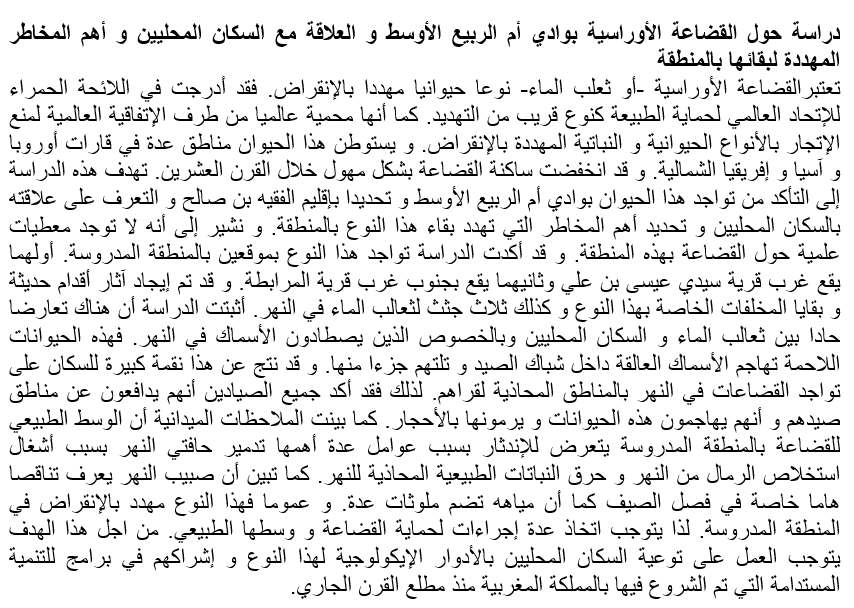IUCN/SSC Otter Specialist Group Bulletin

©IUCN/SCC Otter Specialist Group
Volume 37 Issue 4 (December 2020)
Citation: El Alami, A., Fattah, A. and Chait, A. (2020). A Survey of the Eurasian Otter Lutra lutra and Human-Otter Interaction in the Middle Oum Er Rbia River, Morocco. IUCN Otter Spec. Group Bull. 37 (4): 219 -231
A Survey of the Eurasian Otter Lutra lutra and Human-Otter Interaction in the Middle Oum Er Rbia River, Morocco
Abderrazak El Alami1, 2, 4*, Abderrazzak Fattah3,and Abderrahman Chait1
1Laboratory of Pharmacology, Neurobiology and Behavior, Faculty of Sciences Semlalia, Cadi Ayyad University, Marrakech, Morocco .. Email:: departementbiologiefssm@hotmail.com (*Corresponding Autbor)
2Academy of Education and Training of Beni Mellal-Khenifra, Ministry of National Education, Vocational Training, Higher Education and Scientific Research of Morocco.
3Laboratory of Bio-Geosciences and Materials Engineering, Higher Normal School, Hassan II University, Casablanca, Morocco.
4Khawarezmi High School, 23550 Souk Sebt, Fkih Ben Salah, Morocco
(Received 26th March 2020, accepted 26th May 2020)
Abstract: The Eurasian otter is listed as “near threatened” in IUCN’s Red List of Threatened species and in Appendix I of CITES. In Morocco, Lutra lutra occurs in the Middle and High Atlas, the Rif Mountains and in the plains of the central Morocco. The status of this species in Morocco is far from clear and there is limited available information on its distribution and ecology. Our aim was to confirm the presence of the Eurasian otter in the Middle Oum Er Rbia River, especially in the province of Fkih Ben Salah, to describe any human-otter conflicts and to identify the current and potential threats to the species. Between November 18, 2019 and February 29, 2020, a combination of standardized interviews combined with a field survey to gather information about otters in the study area was used. Results of the interviews and surveys confirmed the presence of this mammal in two sites. Our evidence is based on footprints, spraint and cadavers of otters. We have found that there is a conflict between local people, especially fishermen, and otters due to the competition for fish. Otters are facing extreme threats by human-induced habitat destruction, in particular gravel and sand extraction from the river bed, disturbances by local people, pollution, low water quality and vegetation burning. In conclusion, efforts must be focused on the conservation of this species by protecting its habitat and reducing conflict between local people and otters.
Keywords: Eurasian Otter, Middle Oum Er Rbia River, human-otters conflict, conservation.,
INTRODUCTION
The Eurasian otter Lutra lutra Linnaeus 1758 is the most widely distributed otter species in the world, its range include parts of Europe, Asia and Africa (Nancy and Chris, 2016). Major threats to the surviving populations of Lutra lutra are habitat degradation, pollution, continuous deforestation, construction of hydroelectric power projects, overexploitation, poaching and trading (Mucci et al., 2010; Bhattacharya et al., 2019). This Otter is listed as “near threatened” in IUCN’s Red List of Threatened species (IUCN, 2019), in Appendix I of CITES (CITES, 2019) and in Appendix I of the Bonn Convention. One subspecies, Lutra lutra angustifrons, is endemic to Africa and occurs in Morocco and Algeria (Broyer et al., 1988). In Morocco, Lutra lutra occurs in the Middle and High Atlas, the Rif Mountains and in the plains of the central Morocco (MacDonald and Mason, 1984; Jacoby and Williams, 1995; Cuzin, 2003; Delibes et al., 2012). Healthy otter populations appear to remain in the foothills of the Middle and High Atlas but the trend of populations disappearing from the relatively flat Atlantic, therefore Lutra lutra tended to be confined to less cultivated, mountainous areas (Delibes et al., 2012). The status of this species in Morocco is far from clear and there is limited available information on its distribution and ecology. Recently the species has been sighted in a new locality in the Western Rif Mountains (Waters and El Harrad, 2018).
Little published Data is available on the Eurasian otter in Morocco. There isn`t any information available on their distribution in the Middle Oum Er Rbia River. The objective of this study was to confirm the presence of Lutra lutra in the Middle Oum Er Rbia River, especially in the province of Fkih Ben Salah, an area of about 80 km2, to describe any human-otter conflicts, to identify the current and potential threats to the Eurasian otter, and to make recommendations for the protection of the species in this area.
MATERIALS AND METHODS
Study area
The Oum Er Rbia River is one of the major rivers in Morocco and is 550 km long and has a catchment area of 48 000 km². It originates in the region of Khenifra (32°56′22″N5°40′3″W), located in the Middle Atlas Mountains, and it flows into the Atlantic Ocean at Azemmour city (33°17′16″N8°20′32″W). The study was conducted in the Middle Oum Er Rbia area, province of Fkih Ben Salah, especially between the village of Sidi Aissa Ben Ali in the east and the village of Dar Ould Zidouh in the west (Fig. 1) and comprises an area of about 80 km2. This region belongs to the plain of Tadla which covers an area of approximately 3 600 km². This plain is crossed by the River of Oum Er Rbia. The regions of Sidi Aissa Ben Ali, Ouled Slimane and Lahbabeza (Fig.1) belong to the zone of Beni Moussa which is located on the left of this river. Beni Moussa is a vast irrigated agricultural area covering an area of 695 km². The regions of Lamrabta and Aaribate (Fig. 1) belong to the zone of Beni Amir which is located on the right of the Oum Er Rbia River. Beni Amir is an irrigated agricultural area covering an area of 275 km² hectares. The study region is characterized by a very cold winter and a hot summer. Some of the riparian vegetation types are Tamarix sp., Nerium oleander, Phragmites australis, Ficus carica, Juncus sp., Scirpus sp., Ballota hirsuta, Nicotiana glauca, Olea europea var. sylvestris, and some Populus alba trees near the village of Sidi Aissa Ben Ali.
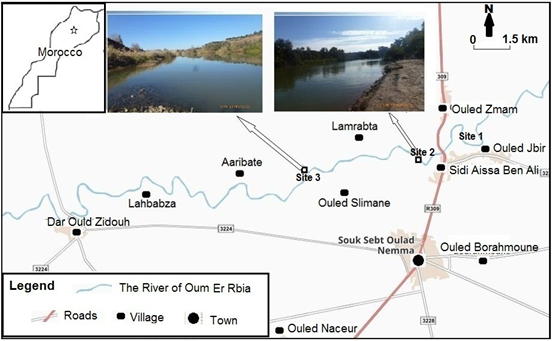
Data Collection
In October 2019, preliminary observations were made on four days in the study site. This period allowed the observers to become familiar with the terrain. Between November 18, 2019 and February 29, 2020, a combination of standardized interviews combined with a field survey to gather information about otters in the study area was used.
Interviews
Preliminary information on the Eurasian otter was obtained through interviews with 48 inhabitants in the study area. The focus was on the inhabitants who work near the river and in particular the shepherds, the wood collectors, the farmers and the fishermen. These people have valuable information on the wild aquatic and semi-aquatic fauna. Interviews were administered in the local language (Darija); motivating the interviewees to speak freely. Color pictures of the Eurasian otter were shown and the main questions asked were: what are the main economic activities of the interviewee? Does he work near the Oum Er Rbia River? Did the interviewees fishes in the river? Did the interviewee recognize the Eurasian otter on the picture? Are Eurasian otter present in the region? What is the period of the day he/she observed them? Are otters present year-round or seasonally? Are otters captured and/or killed in the region? What are advantages and disadvantage of the otter’s presence?
Surveys
Five surveys were conducted in the Middle Oum Er Rbia, in the region limited by the village of Ouled Jbir to the east and the village of Lahbabza in the west (Fig. 1). To search for otters, the observers moved slowly and quietly along the River of the Middle Oum Er Rbia to look for evidence of otters including spraints, footprints, food remains, cadavers, soil displacement and grooming and rolling areas. Otter’s footprints and scats were compared with those of the specimens living in the Rabat Zoo and with published data (e.g. Bhattacharya et al., 2019).
RESULTS AND DISCUSSION
Distribution of Lutra lutra in the study area
Interviews results showed that 65 % of the interviewees confirmed the presence of Lutra lutra in three sites in the Middle Oum Er Rbia: in Ouled Jbir (site 1, Fig. 1), in site called ‘la Chutte’ located to west of the village of Sidi Aissa Ben Ali (site 2, Fig. 1), and in the south west of the village of Lamrabta (site 3, Fig. 1). The inhabitants who confirmed the presence of otters are the people who frequent permanently the river (shepherds, fishermen and farmers). Other people do not know that otters exist in the river although they live in villages near this river. In the study area, the local name of the Eurasian otter is ‘Kalb Alma’. ‘Kalb’ means the dog and ‘Alma’ means the water. This name comes from the morphological resemblance between the otter and the dog and its semi-aquatic way of life. The majority of interviewees reported that the population of the Eurasian otter decreased in the study region in the past decades.
Results of the surveys confirmed the presence of Lutra lutra in two sites: in ‘La Chutte’ (site 2, Fig.1) and in the south west of the village of Lamrabta (Site3, Fig. 1). In Ouled Jbir (site 1, Fig. 1), although 11 local inhabitants confirmed the observation of an otter's cadaver near this village in 2019, we did not find any sign of the actual presence of otters. In the sites 2 and 3, we found spraints (Fig. 2, Fig. 3) and footprints of otters (Fig. 4). According to inhabitants who frequent the river at night, at least 7 otters were observed in site 2, and 5 otters in site 3. In the south west of the village of Lamrabta (site 3, Fig. 1), we found cadavers of two juvenile otters (Fig. 5). Results of the interviews showed that the two dead otters were not killed by inhabitants. The majority of the interviewees who frequent permanently the river confirmed that they find cadavers of dead otters in the river during the last two years. Observation of the scats found showed the presence of scales and fish bones with a dominance of the shells of freshwater gastropods, namely the subclass of Prosobranchs and other taxa of Gastropods. The presence of these preys in the otter’s diet has been already confirmed by several studies (Mason and Macdonald, 1986, 1993; Lanszki and Kormendi, 1996; Kingston et al., 1999; Lanszki and Molnar, 2003; Lanszki and Sallai, 2006).
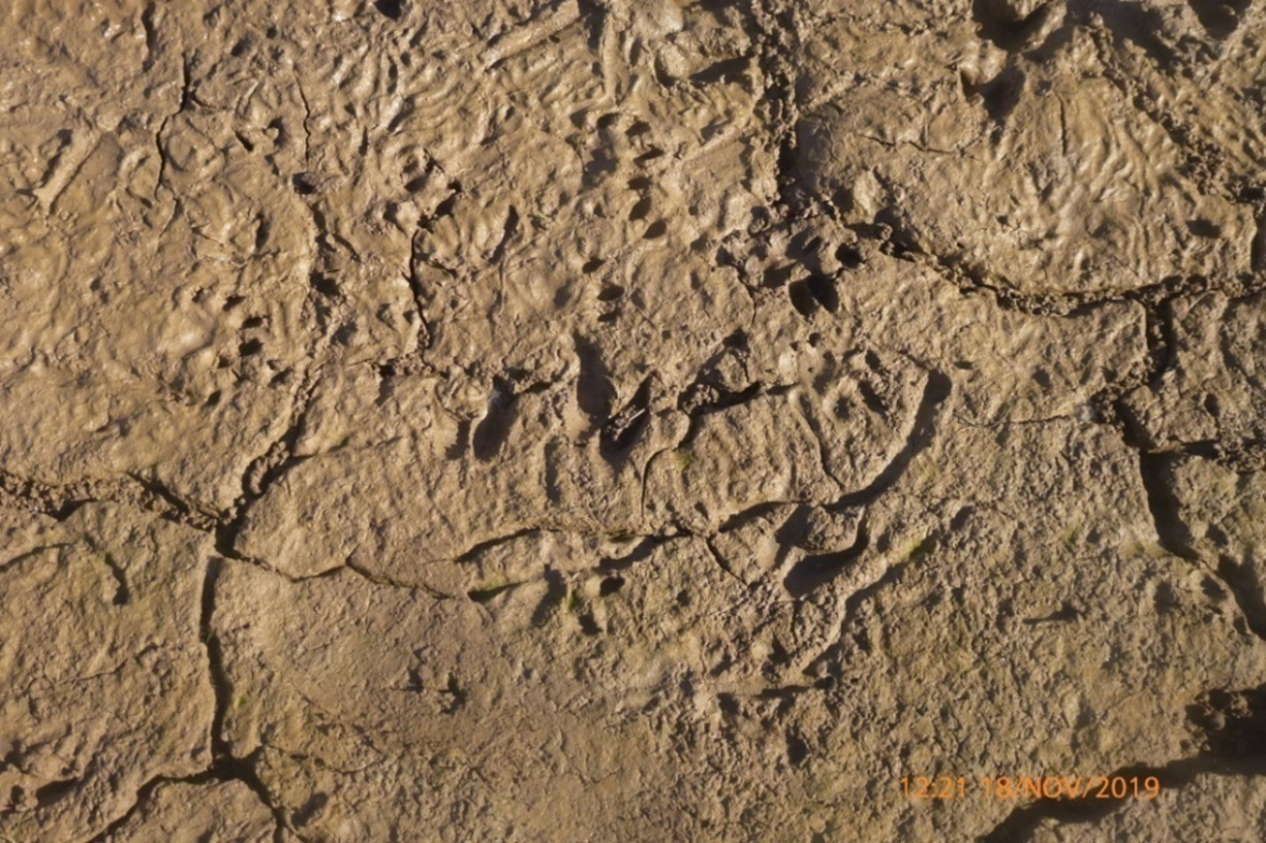
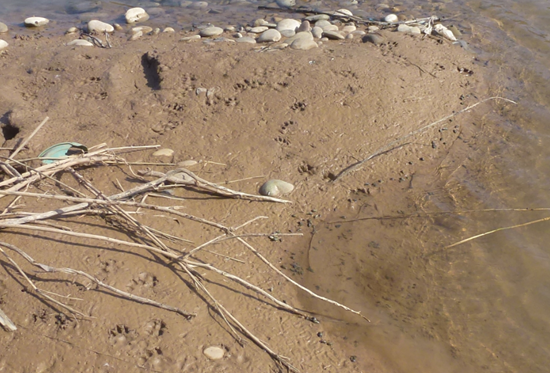

Lamrabta (site 3, Fig. 1). (February 2020).
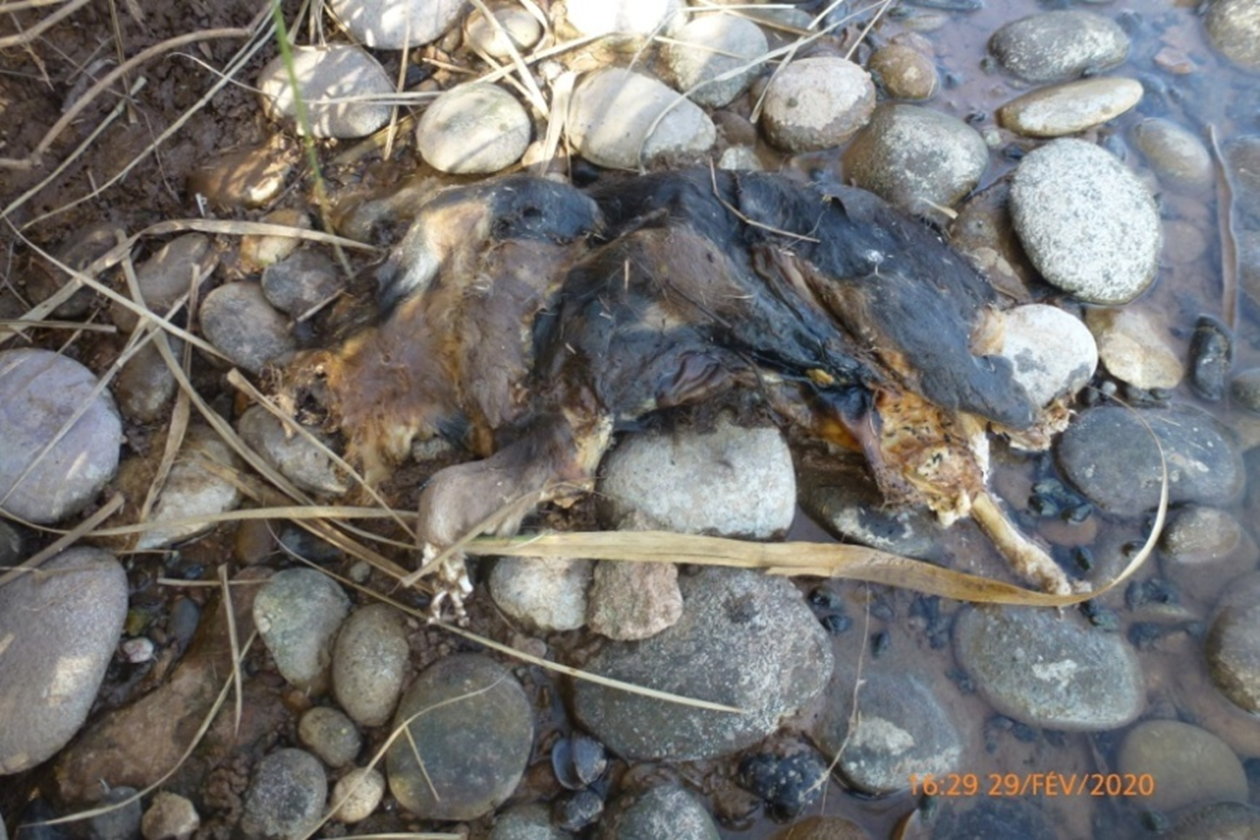
In this study, we were unable to photograph otters in the study region. Otters are quite difficult to see in the wild. In the study region, they are very discreet and they flee from humans because inhabitants throw stones at them. These mammals are principally nocturnal or crepuscular and they spend a lot of time in the water. In addition, the study region is frequented by fishermen and other inhabitants overnight. For this reason we were not allowed to install the camera during the time required to collect additional data. Several researchers were unable to photograph otters, although they installed cameras for months. For example, at Sungai Relau and Sungai Ceruai, seven months of continuous camera trapping, riverbank surveys and observations resulted in no Hairy-nosed Otter records (Fernandez, 2018).
During the study period we recorded three otters died, two juveniles and one adult, but the causes of this mortality remain unknown. Several factors can be responsible for this mortality, namely water pollution, food shortage, inter and intra-specific competition. In the wild otters, many factors can lead to death. Kruuk and Conroy (1991) reported that food shortage was considered to be the ultimate cause of natural mortality in coastal dwelling otters in Shetland, with the effects of mercury and perhaps polychlorinated biphenyls (PCBs) as contributing factors (Mason, 1989, 1995).
Local People-Otter Conflict
Interview results showed that the Eurasian otter is viewed unfavorably in the study region (78 % of the interviewees). Only few interviewees in the study region (3 % of the interviewees) recognized the ecological and cultural values of the presence of this mammal in the River. We have found that there is a conflict between local people, especially fishermen, and otters due to the competition for fish. All interviewed fishermen reported that otters are responsible for the decrease of the amount of fishing in the river. In this region, fishermen use two methods. The first is the fishing rod. The second technique consists to use of large fish net. Fishermen spread the fishing net between the two banks of the river and the current brings the fish back to the net. The trapped fish are then removed by hand or by shaking the net. This technique, called ‘Jerraf’ by local people, allows catching significant quantities of fish. But the otters catch the trapped fish in the net and this is the main factor for the presence of the conflict with local people. Consequently, otters constitute for fishermen unwanted animals.
Humans and otters share habitats and explore similar resources. In the study region, there is an increase in negative interactions between otters and inhabitants. All interviewed fishermen reported that the most common response to the observation of otters is to keep them out of site where they installed their fishing net. No otter mortality from fish net entanglement was reported in the study area. Some interviewees declared that they throw stones at otters. At least three otters have been killed by stone throwing during the last years. In several European and Asian countries, Lutra lutra is persecuted for being a nuisance to fisherman, eating fish and playing in rice fields (Rasooli et al., 2007). In many Central European countries, conflicts arising from Lutra lutra predation on commercial fish are nowadays a common phenomenon (Poledníková et al., 2013). Mirzajani (1999) reported that the most recent conflicts between humans and otters in Iran are in relation to fishery activities and around fish farm ponds where many dead otters have been found (in: Naderi et al., 2017). But in many cases, although the fishermen attribute fish losses to otters, scientific data show that otters are no threat to fish farming (Bodner, 1995).
Habitat Conversion and Destruction
In the study area, there is a growing demand for sand and gravel, especially for construction purposes. Therefore rivers are subject to heavy exploitation due to sand and gravel extraction. Survey results showed that the Banks and the bed of the Oum Er Rbia River are extensively exploited by humans, especially in the south of the Lamrabta village. In some sites, the banks have been completely destroyed with elimination of riparian vegetation (Fig. 6). These works have a negative impact on the otter population because of the destruction of their habitat. Otters live in underground burrows protected by riparian vegetation. Young otters cannot swim until they are three months of age. In the study region, otters survive in inaccessible sites as shelters. The preferred sites are inaccessible to humans and have dense riparian vegetation. Information from interviews has indicated a dramatic decline of Lutra lutra population in this region since the companies began extracting sand and gravel from the river. All the interviewed fishermen confirmed that there is a decrease of the amount of fishing in the river since the companies began extracting sand and gravel from the river.
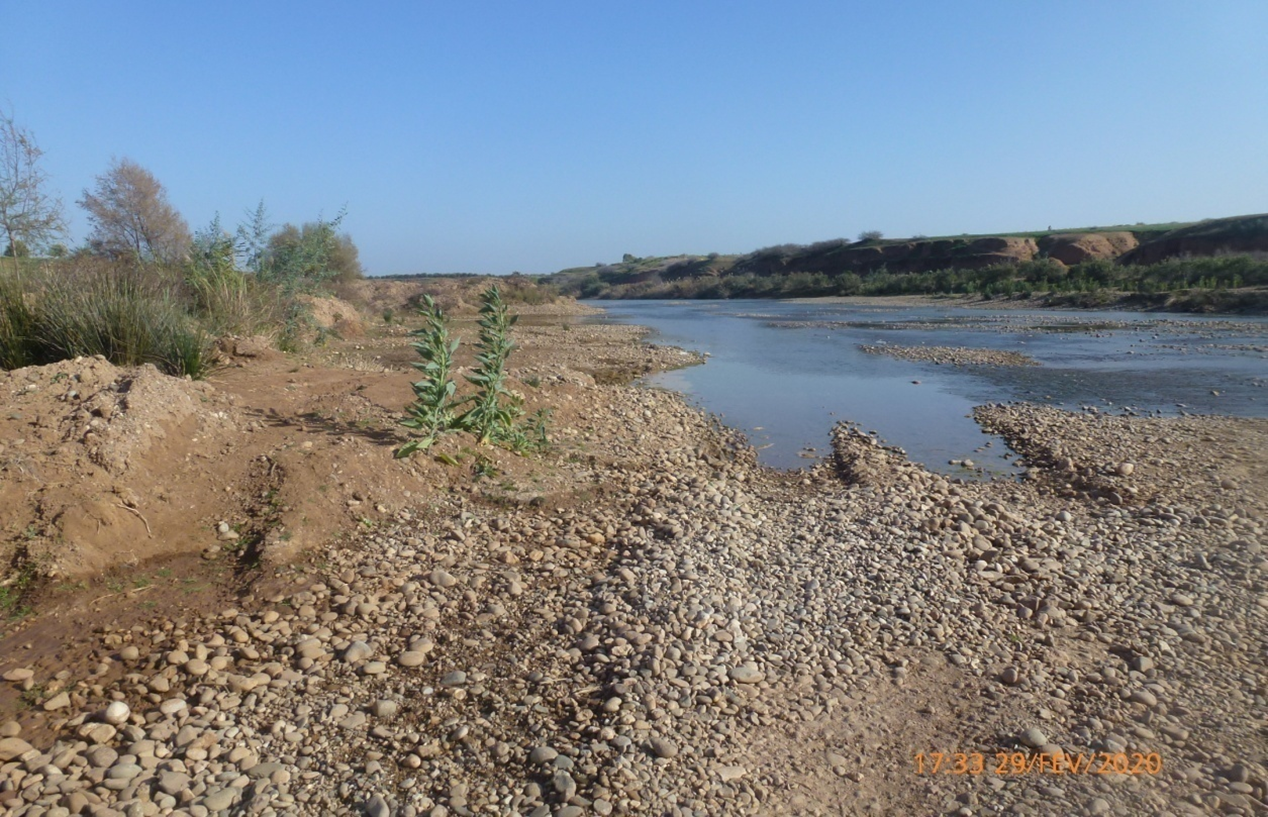
The extraction of sand and gravel from this river affect the riparian vegetation. In some sites, the vegetation is removed completely. This will influence the food supply of otters as well as reducing cover. The removal of riparian vegetation has been one of the major impacts on the river ecosystem (Mason, 1995). For example, habitat degradation and transformation of river valleys has been recognized as one of the reasons for the pan-European disappearance of otters (Foster-Turley et al., 1990). In some cases, habitat degradation could only to some extent limit the density of otters. Several studies have found relationships between the number of otter signs and bank side cover. For example, Macdonald and Mason (1984) reported that the number of signs of otters was significantly correlated with the density of mature Fraxinus excelsior and Acer pseudoplatanus trees and with the number of potential holts, 46% of which were in the root systems of these trees (In: Mason, 1995).
River Low Flows and Pollution
The Oum Er Rbia River originates in the Middle Atlas Mountains. From its source, the Oum Er Rbia River covers more than 200 km. All interviewees confirmed that the river flow has decreased in the last decade. The low flow is due to the building of dams, to water abstraction for irrigation and to river flow droughts. The river receives agricultural drainage from agricultural lands and the treated and untreated industrial and domestic wastewater from many towns and villages. During our study, wide varieties of waste including plastic bags and bottles were found in the river. All the interviewed fishermen confirmed that in recent years, the cases of fish mortality have increased in the River. During surveys, we frequently observed dead fish floating in the Middle Oum Er Rbia River (Fig. 7). According to personal observations and information from reviews, the cases of fish mortality have increased in November-February every year. In this period, olive oil mills harvest the olives to extract the juice necessary for the production of olive oil. These olive oil mills produce, as a waste material, a dark liquid rich in toxic substances (Hamdi, 1991) and a large amount of this liquid is poured into the secondary streams which transport it towards the river. The river must contain various pollutants resulting from human activities, especially industry, agriculture and household. These pollutants have many effects on the aquatic flora and fauna in the river.
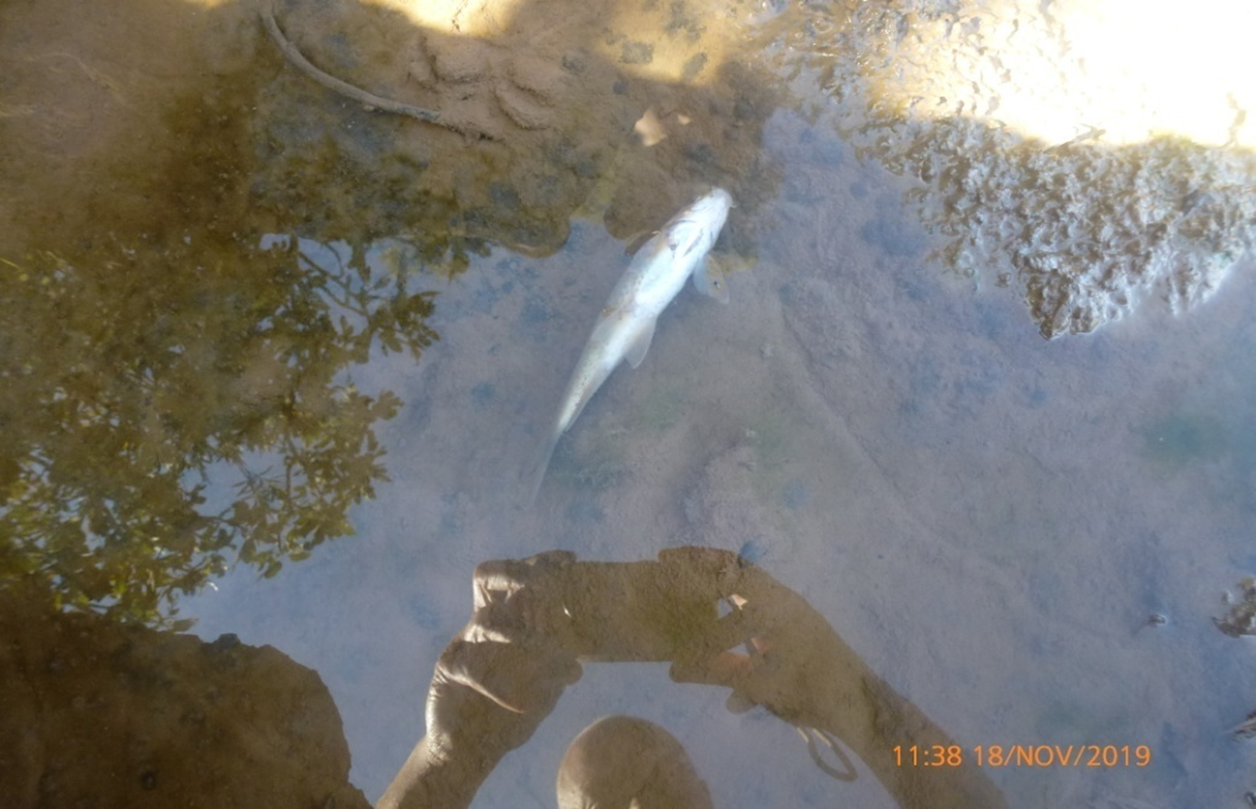
The vulnerability of water resources pollution of the River of Oum Er Rbia and its tributaries is due to strong agricultural and industrial activity including oil mills, phosphate extraction, livestock farming, and sugar beet processing (Barakat et al., 2016). These authors reported that the Oum Er Rbia River water is affected from the pollutants in the river catchment area and highlighted the need to treat industrial and municipal wastewater and to encourage sustainable agricultural practices to prevent adverse health effects (Barakat et al., 2016). Water quantity is important to otters, especially where low flows destroy the food base, namely fish (Mason, 1995).
Vegetation Burning
Survey results showed that the riparian vegetation is burned in some places. In this region, vegetation burning is practiced by inhabitants during certain times of the year. One of the main goals is the eradication of spontaneous vegetation and encouraging the growth of Phragmites australis. This plant tolerates fire if water is above the soil. It is used by local people for multiple purposes. Fires affect animals and damage their habitat. During surveys, we observed carcasses of animals dying from burning vegetation (e.g. Fig. 8). Animals affected directly by fires include birds, reptiles, mammals (e.g. otters, rodents, hares and red fox), insects and frogs. Fires affect otters because of the destruction of their habitat and effects on their preys. We observed that the burned sites are the same places as are suitable places for otter burrows.
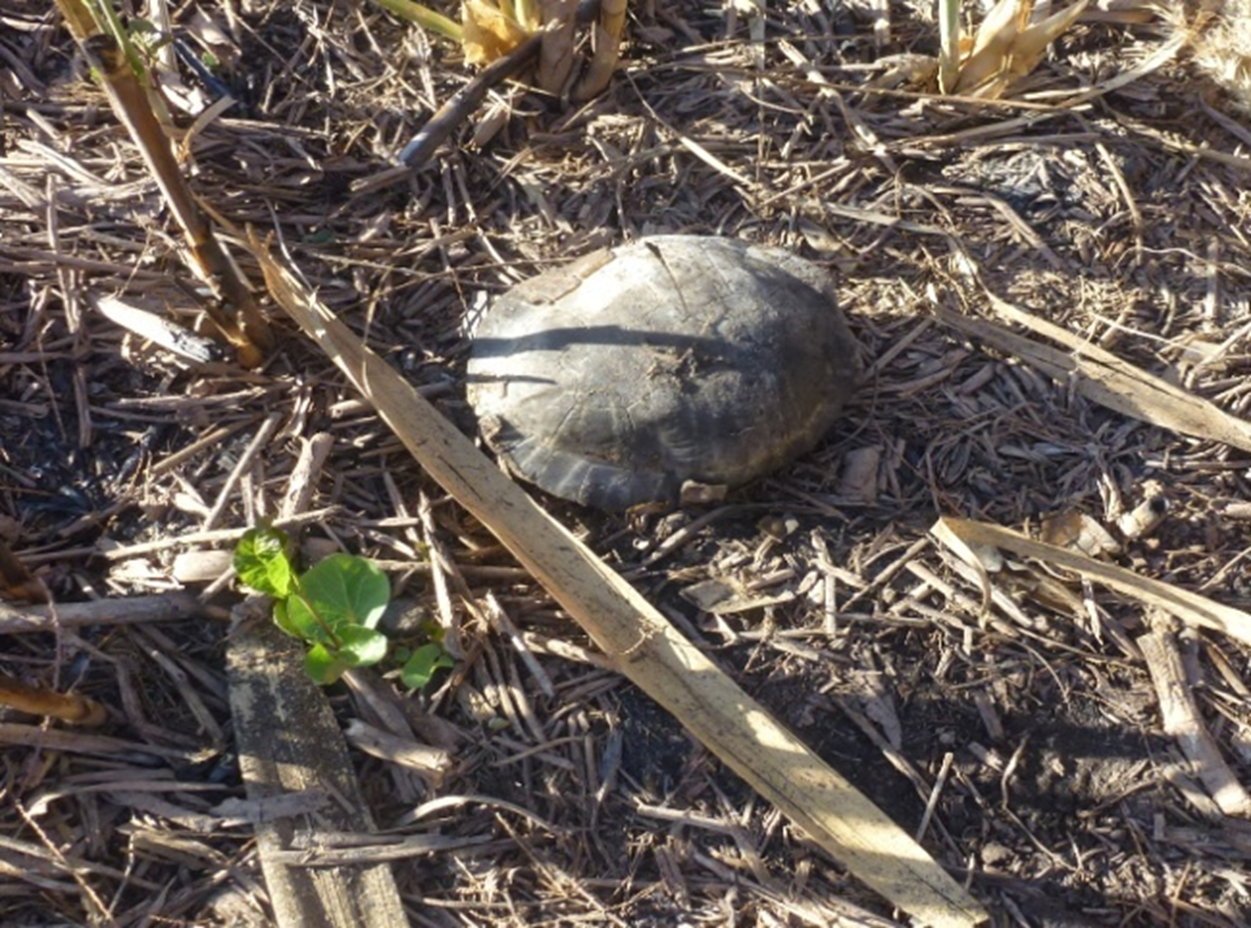
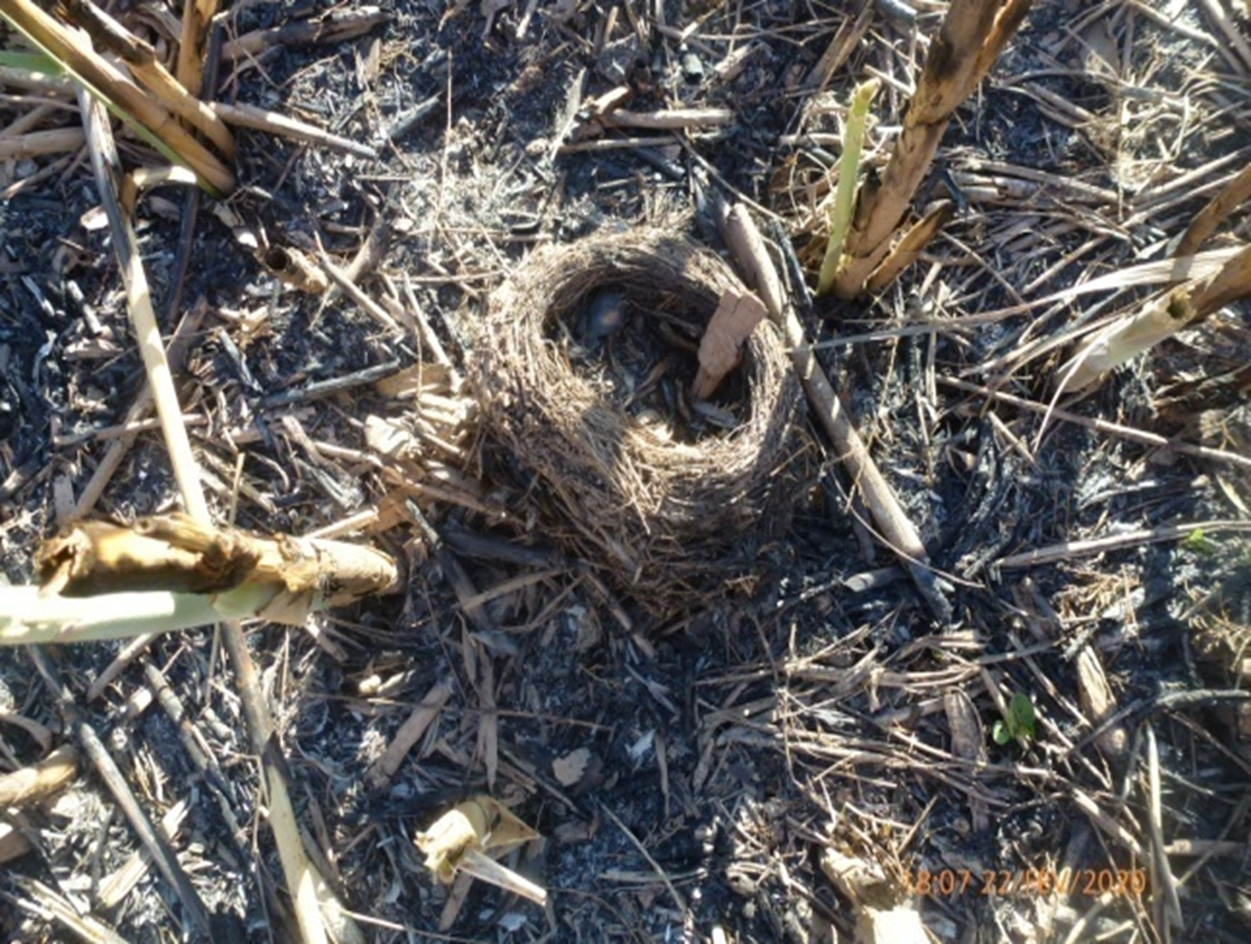
CONCLUSION
The Eurasian otter has categorized as Near Threatened in IUCN’s Red List of Threatened species and in Appendix I of CITES. Although the results of this study confirmed the presence of Lutra lutra in two sites in the Middle Oum Er Rbia River, it seems that Lutra lutra may be threatened in the study area. Otters are facing extreme threats due to human-induced habitat destruction, disturbances by local people, pollution, low water quality and vegetation burning. We suggest that cohabitation with humans is possible in this region. During the study period, we have held discussions with local people living or working near the Middle Oum Er Rbia River on the ecological roles of otters and the benefit from their presence in the river. We have explained in particular how this otter regulates the populations of many species of fish, invertebrates, reptiles, amphibians and rodents.
Conservation of the Lutra lutra population is required to increase habitat protection, to raise the awareness of local people about the conservation of otters, to encourage research and development projects involving local communities, local authorities and associations in the surveillance of the wild fauna. Finally, it is extremely urgent to find solutions for pollution problems in the Oum Er Rbia River and its tributaries, especially as Morocco ratified the Stockholm Convention in June 2004, which calls for the elimination of the use of PCBs in equipment by 2025, and the Basel and Rotterdam Conventions regarding hazardous waste.
Acknowledgements: We thank the local inhabitants of the villages of Souk Sebt, Sidi Aissa Ben Ali, Masghouna, Ouled Jbir and Lamrabta who participated or helped to conduct this study. We would like to acknowledge Mr. Kheili Tarik (Khwarezmi High school, Souk sebt; village of Masghoun, Lamrabta) and his brothers, Professor El Ghaouat El Habib (Khwarezmi High school, Souk sebt), Ms. Jane Raymond (Rufford Small Grant Foundation, UK). We are highly indebted to Rufford Small Grant Foundation, UK for providing funding for our Project “Human–Carnivore Conflict and Threatened Species Management and Conservation in the Central High Atlas Mountains, Morocco”.(https://www.rufford.org/projects/abderrazak_el_alami). Finally, we warmly thank the AESVT association, the organization receiving the Rufford fund on behalf of the first author. We are grateful to the Board Member's of Beni Mellal section of this association, especially Mrs Abdelwahab Semlali, Mustapha Hajji, Mohamed Bentouina, Driss Massmoudi, Alami Ali, Houcine El Hachimi and Malika Salmane.
REFERENCES
Barakat, A., El Baghdadi, M., Rais, J., Aghezzaf, B., Slassi M. (2016). Assessment of spatial and seasonal water quality variation of Oum Er Rbia River (Morocco) using multivariate statistical techniques. International Soil and Water Conservation Research 4(4): 284-292.
Bhattacharya, M., Watham, T., Gopi, G.V. (2019). Photographic Records of Eurasian Otter (Lutra lutra Linnaeus, 1758) from Nyamjang Chu River, Arunachal Pradesh, India. IUCN Otter Spec. Group Bull. 36(2): 103-109.
Bodner, M. (1995). Fish loss in Austrian fish-ponds as a result of otter (Lutra lutra L.) predation. IUCN Otter Spec. Group Bull. 12: 3-10.
Broyer, J., Aulagnier, S., Destre, R. (1988). La loutre Lutra lutra angustifrons Lataste, 1885 au Maroc. Mammalia 52:361-370.
CITES (2019). Convention on International Trade in Endangered Species of Wild Fauna and Flora. Appendices I, II and III. https://www.cites.org/eng/app/appendices.php
Cuzin, F. (2003). Les grands Mammifères du Maroc méridional (Haut Atlas, Anti Atlas et Sahara): Distribution, écologie et conservation. PhD theses, University of Montpellier II, Montpellier. pp. 340.
Delibes, M., Calzado, J., Clavero, M., Fernandez, N., Gutierrez-Exposito, C., Revilla, E., Roman, J. (2012). The near threatened Eurasian Otter (Lutra lutra) in Morocco: No sign of recovery. Oryx 46:249-252.
Fernandez. K, (2018). Status of the Hairy-Nosed Otter (Lutra Sumatrana) In Peninsular Malaysia. IUCN Otter Spec. Group Bull. 35(2):85-96.
Foster-Turley, P., Macdonald, S., Mason, C. (eds) (1990). Otters: An Action Plan for their Conservation. IUCN, Gland, 126 pp.
Hamdi, M. (1991). Nouvelle conception d'un procédé de dépollution biologique des margines, effluents liquides de l'extraction de l'huile d'olive. PhD theses, University of Provence, 180 pp.
IUCN Red list of Threatened Species (2019). “Lutra lutra (Common Otter, Eurasian Otter, European Otter, European River Otter, Old World Otter). https://www.iucnredlist.org/species/12419/21935287
Jacoby, M.C., Williams, L.R. (1995). Recent otter records from central Morocco. IUCN Otter Spec. Group Bull. 12:11-12.
Kingston, S., O’Connell, M., Fairley, J.S. (1999). Diet of otters Lutra lutra on Inishmore, Aran Islands, west coast of Ireland. Biol. Environ.:Proc. R. Irish Acad. 99B(3): 173-182.
Kruuk, H., Conroy, J.W.H. (1991). Mortality of Otters (Lutra lutra) in Shetland. Journal of Applied Ecology 28(1): 83-94.
Lanszki, J., Kormendi, S. (1996). Otter diet in relation to fish availability in a fish pond in Hungary. Acta Theriol. 41: 127-136.
Lanszki, J., Molnar, T. (2003). Diet of otters living in three different habitats in Hungary. Folia Zool. 52: 378-388.
Lanszki, J., Sallai, Z. (2006). Comparison of the feeding habits of Eurasian otters on a fast flowing river and its backwater habitats. Mamm. Biol. 71: 336-346.
MacDonald, S.M., Mason, C.F. (1984). Otters in Morocco. Oryx 18(3):157-159.
Mason, C.F. (1989). Water pollution and otter distribution: a review. Lutra 32(2): 97-131.
Mason, C.F. (1995). Habitat quality, water quality and otter distribution. Hystrix 7(1-2): 195-207.
Mason, C.F., Macdonald, S.M. (1986). Otters: Ecology and Conservation. Cambridge, London, New York, New Rochelle, Melbourne, Sydney: Cambridge University Press. 236 pp.
Mason, C.F., Macdonald, S.M. (1993). Impact of organochlorine pesticide residues and PCBs on otters (Lutra lutra): a study from western Britain. Science of the Total Environment 138: 127-145.
Mirzajani, A. (1999). Study on common otter (Lutra lutra) status. The Environment [in Farsi] 25: 70-74.
Mucci, N., Arrendal, J., Ansorge, H. et al. (2010). Genetic diversity and landscape genetic structure of otter (Lutra lutra) populations in Europe. Conservation Genetics 11: 583-599.
Naderi, S., Mirzajani, A., Hadipour, E. (2017). Distribution of and threats to the Eurasian otter (Lutra lutra) in the Anzali wetland, Iran. IUCN Otter Spec. Group Bull. 34(2): 84-94.
Nancy, H., Chris, J.L. (2016). Lutra lutra (Carnivora: Mustelidae), Mammalian Species 48(940): 109-122.
Poledníková, K., Kranz, A., Poledník, L., Myšiak, J. (2013). Otters causing Conflicts the Fish Farming Case of the Czech Republic. R.A. Klenke et al. (eds.), Human-Wildlife Conflicts in Europe, Environmental Science and Engineering, Springer-Verlag Berlin Heidelberg 2013.
Rasooli, P., Kiabi, B.H., Abdoli, A. (2007). On the status and biology of the European otter, Lutra lutra (Carnivora: Mustelidae), in Iran. Zoology in the Middle East 41:25–29.
Waters, S., El Harrad, A. (2018). New location for the Eurasian otter Lutra lutra in the catchments of the western Rif Mountains of Morocco. IUCN Otter Spec. Group Bull. 35: 230-234.
Résumé: Étude de Lla Distribution de la Loutre Lutra lutra, de son Interaction avec les Habitants Locaux et des Principales Menaces à sa Survie dans la Riviere du moyen Oum Er Bia, au Maroc
La loutre Eurasiatique Lutra lutra est classée comme une espèce quasi-menacée dans la liste rouge de l’union internationale pour la conservation de la nature (UICN). En plus, elle est listée dans l'annexe I de la convention sur le commerce international des espèces de faune et de flore sauvages menacées d'extinction (CITES). Actuellement, Lutra lutra est la seule loutre à l’état sauvage qui vit dans l’Afrique du Nord. Son aire de répartition couvre la majorité de l’Europe, de l’Asie et de l’Afrique du Nord. Au Maroc, ce carnivore occupe les principales rivières du Moyen Atlas, du Haut Atlas, du Rif et des plaines du centre du pays. Les études scientifiques réalisées sur l’espèce sont rares. Cette étude a été effectuée en 2019-2020, elle s’intéressait à l’étude de la distribution de Lutra lutra dans la rivière d’Oum Er Rbia. Dans cette étude, la méthode suivie a consisté à mener des enquêtes avec les habitants locaux, puis à collecter de nouvelles données par exécution de sorties pour observation sur le terrain à la recherche directe et indirecte des loutres. Les résultats ont montré que la loutre Eurasiatique existe actuellement dans deux sites. La présence des loutres a été confirmée par l’observation des épreintes et des traces de leurs pattes. En plus, nous avons trouvé trois cadavres des loutres mortes dans la région de l’étude. Les résultats des enquêtes ont montré que le conflit entre les habitants locaux, en particulier les pêcheurs, et les loutres ne cessent d’augmenter. Les observations faites au terrain ont montré que l’habitat de la loutre est soumis à une forte pression anthropique. A cause des travaux de prélèvement de sables et des graviers du lit de la rivière, une grande partie des deux rives a été détruite. En plus, la végétation riveraine, indispensable à la survie des loutres, a été brulée par les habitants pour des fins économiques. La rivière reçoit également divers polluants d’origine domestique, agricole et industrielle. En général, cette loutre est menacée d’extinction dans la région de l’étude. La présente étude suggère que la survie de Lutra lutra dans cette région dépend de prendre des mesures de protection de son habitat.
Revenez au dessus
Resumen: Relevamiento de Nutria Eurasiática Lutra lutra y de la Interacción Humanos-Nutrias en el Tramo Medio del Río Oum Er Rbia, Marruecos
La nutria eurasiática está categorizada como “casi amenazada” en la Lista Roja de Especies Amenazadas de UICN, e incluida en el Apéndice I del CITES. En Marruecos, Lutra lutra ocurre en los Atlas Medio y Alto, las Montañas Rif, y las planicies de Marruecos central. El status de esta especie en Marruecos está lejos de estar claro, y hay disponible información limitada sobre su distribución y ecología. Nuestro objetivo fue confirmar la presencia de nutria eurasiática en el tramo medio del Río Oum Er Rbia, especialmente en la provincia de Fkih Ben Salah, y describir cualquier conflicto que hubiera entre humanos y nutrias, así como identificar las amenazas actuales y potenciales para la especie. Entre el 18 de Noviembre de 2019 y el 29 de Febero de 2020 utilizamos una combinación de entrevistas estandarizadas, y un relevamiento de terreno para recolectar inormación sobre las nutrias en el área de estudio. Los resultados de las entrevistas y los relevamientos confirmaron la presencia de este mamífero en dos sitios. Nuestra evidencia está basada en huellas, fecas y marcas olorosas, y cadáveres de nutrias. Encontramos que hay un conflicto entre la gente local, especialmente pescadores, y las nutrias, debido a la competencia por los peces. Las nutrias están enfrentando amenazas extremas debido a la destrucción de hábitats inducida por el hombre, en particular extracción de grava y arena del lecho del río, disturbios por los habitantes locales, contaminación, baja calidad del agua y quema de vegetación. En conclusión, deben enfocarse esfuerzos de conservación sobre esta especie, protegiendo su hábitat y reduciendo el conflicto entre la gente local y las nutrias.
Vuelva a la tapa



